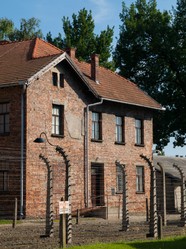Most people know of the name Zarathustra only from Nietzsche's work, Thus spake Zarathustra, penned in the nineteenth century. Nietzsche believed that Judaeo-Christian morality and indeed religious morality in general was for slaves, unlike the morality that he extolled, the lifestyle of the hero, the great man whose greatness enabled him to transcend good and evil. [Note, ladies great man. Women, he thought, did not qualify.] Yet even more than Moses, Nietzsche blamed Zarathustra for the key tenet of religious morality, the idea that life was a battle between good and evil;and in this respect Nietzsche was probably right.
So who was Zarathustra? Estimates of his dates vary, ranging from 2000 to 600 BCE, but recent research has placed him about 1200, an intermediate date that is probably right. He was a priest of the ancient Iranian religion, and a peace-loving man who detested the wandering Aryan tribes who blighted the lives of the peaceable agriculturalists with whom he identified. These people worshipped the devas, especially Indra, while despising as lower deities the Ahuras [asuras] of the peoples that they dominated. Zarathustra staked his flag for the ahuras, despising the devas, and it is likely that from him we get the word devil.It is notable that Hindus still worship devas and relegate asuras to the nether realms
Zarathustra's religious experience came in a moment when he was gazing into a fire. He believed that addressing him through the flames was Ahura Mazda, the deity of light, truth and goodness. Mazda wanted to commission Zarathustra and his followers to work for his cause, promoting light, truth and goodness against the power of his arch-foe, Angrya Manyu, sometimes known as Ahriman. Ahriman was the force of evil in the world fighting against Mazda, and his technique was to use Druj, the lie. The religious experience in the fire has uncanny similarities to Moses' experience of the burning bush, which may have occurred two or three hundred years earlier. But since then the Zoroastrians have revered fire as sacred and so never cremate their dead, as death pollutes the sacred element. There is a Zoroastrian temple in Eastern Iran where a sacred flame has been burning since time immemorial as part of Zoroastrian worship.
Later Zoroastrian thought was to associate Mazda with seven assistants, the Amesa Spentas, the Bounteous Immortals, beings of archangelic status, one of whom was Mithras, whose cult was popular among Roman soldiers, and another of whom is still honoured now by the persecuted Yazidis of Iraq, who know him as the Peacock Angel.
It was the followers of Zarathustra who first realized that there would be a final battle between good and evil when the forces of goodness would be led by a saoshyant [saviour] when Ahriman would be defeated. They also believed that there would be a resurrection of the righteous dead to a paradisal condition.
You will notice that these ideas seem familiar, and they are. But the dispute is whether Zoroastrianism influenced Judaism or vice versa.There is no doubt that the two religions were in contact for many hundreds of years, so some interchange of ideas is likely.




 Women of the Gospelson 10/11/2025
Women of the Gospelson 10/11/2025
 Religious Gardenson 08/25/2025
Religious Gardenson 08/25/2025
 Doctor of the Church: John Henry Newmanon 08/03/2025
Doctor of the Church: John Henry Newmanon 08/03/2025
 Restoring the Palm Houseon 07/16/2025
Restoring the Palm Houseon 07/16/2025



Comments
Matthew's gospel says that when Joseph discovered that Archelaus had becomen tetrarch of Judea in his father's place he did not stay in Judea but went to Galilee. This indicates that the Holy Family stayed in Egypt just long enough for Herod to die, so The time that they spent was short, maybe two years.
There were tensions in parts of Egypt between Jews and Egyptians, so Joseph did not really want to stay there longer than necessary.
Thank you for your comment below, in answer to my previous observation and question.
The Holy Family exiled for quite some time in Egypt. What is your "best guess" -- ;-D -- as to how long that exile lasted and as to what year might have been their return?
None. Jesus was born between 7 and 4 B.C, but tradition has it that the Magi arrived some time after the birth. Herod was still alive until 4 B.C.. so the flight into Egypt took place between 7 and 4 B.C..
Thank you for your comment below, in answer to my previous observation and question.
The Holy Family fleeing to Egypt furnishes quite a brave adventure story. Is there any document or any tradition that gives exact or general dates of that famous flight?
Camels, I believe, were only introduced to the Middle East about AD 300.
Please accept my apologies if I ask this question twice in a row.
The computer crashed yesterday before I concluded another component to my comment below. It just crashed before I completed that component just now. It does not divulge immediately whether it did away completely or partially with that destroyed inputing.
Some online sources discuss the Holy Family doing their journey by camel. They explain a camel as cooperative with baskets on each side for at least two passengers.
Might Jesus Christ have been young enough to have made such a journey only as a camel-carried passenger?
(Wasn't Alfred the Great even younger when he walked all the way from the British Isles to Rome and back?)
Thank you for your comment below in answer to my previous observation and question.
The Holy Family on such a long journey intrigues me.
Might each one have had their own donkey?
Matthew's gospel does not say anything about the Holy Family having companions on the journey. But Mary and Joseph would have taken the highway to Egypt, which was a busy route, so they might have joined a group on the way.
Thank you for your comment below in answer to my previous observation and question.
The Holy Family escaping to Egypt intrigues me.
In part, it's because some New Mexican Catholics, such as Bless me, Ultima author Rudolfo Anaya (Oct, 30, 1937-June 28, 2020), invoke as New-World legends stories of, for instance, the Holy Family wrong-turning on route to Egypt and arriving in ancient New Mexico!
Would the Holy Family have been on their own or part of a group escaping to Egypt?
The Zoroastrian influence was in the post-exilic period down to Alexander's conquests, about 527-333 BC.
We know not where the Holy Family lived in Egypt,but there was a large Jewish population in Alexandria, where they would have got support.
There is a legend of unproven provenance that was said to have been found in the Himis manuscript detailing Jesus' journeys in the East. But few scholars have had access to the text, so it must be treated as dubious.This story has him spending teenage years up to the age of 29 in the East.